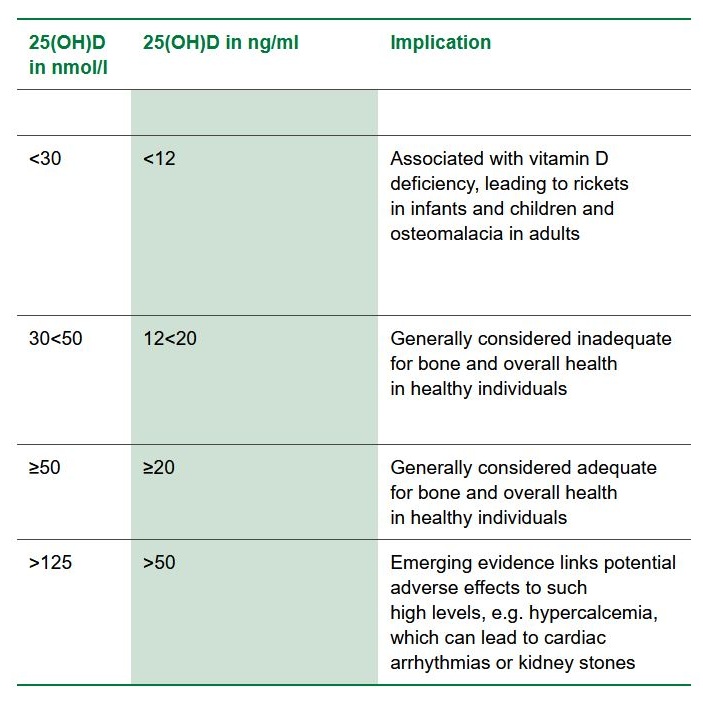
Sunlight
Vitamin D – When the sun gets under your skin
Everyone is talking about it: vitamin D. Why? Let’s take a quick look at this sunshine hormone.
Vitamin D plays an important role in some of our articles on our sun care website. The reason is quite simple: Vitamin D production is closely connected to the sun and has been proven to be very important for different processes in the human body.
In this article, we are not talking about vitamin D as the “superstar” among vitamins and hormones, nor that vitamin D is a miracle weapon in the fight against countless diseases. These types of representations and stories have been seen more recently in the media. So far, these are only partial claims or they aren’t well-founded nor scientifically proven. Instead, they are observations and hypotheses from studies that have yet to be proven and need further research.
Researchers, doctors and advocates of vitamin D disagree about the cause and effects, as well as the triggers or consequences relating to illnesses. In other words, it has not yet been proven whether a deficiency in vitamin D can trigger a certain disease or whether the deficiency was caused by the disease. This is a small but important piece of the mosaic needed to give us the right picture. One way or another, vitamin D is much more than “just” a vitamin. Vitamin D comprises of a group of fat-soluble vitamins, technically known as calciferols.
This was discovered by Adolf Otto Reinhold Windaus, Professor of Chemistry at the University of Göttingen and Director of the General Chemical Institute. The natural compound chemist received the Nobel Prize in Chemistry for his achievements in 1928.
Windaus was also involved in the development of a drug to treat rickets, a condition that particularly affects children with a vitamin D deficiency.
Technical Terminology in the vitamin D world that may appear from time to time:
7-dehydrocholesterol: sterol and precursor for vitamin D3
Calcitriol: The active form of the previtamin D3
D3: vitamin D in animal sources
D2: vitamin D in plant sources
Colecalciferol: technical term for vitamin D3.
Calcidiol: precursor of active vitamin D3
25 (OH) D3: scientific name for calcidiol
25-Hydroxyvitamin D3: scientific name for Calcidiol
Ergocalcifero: scientific name for D2
This shows that one important function of vitamin D for the human body has already been proven: bone health is directly dependent on enough vitamin D in the body. Without enough absorption of vitamin D, children are at risk for rickets and adults are at risk of osteoporosis and osteomalacia. Decalcification and softening of the bones, disturbed bone growth and deformation of the bones are both painful and pathological consequences that need to be prevented. It is also known that vitamin D takes on important control functions of various genes and is involved in various metabolic processes as well as the formation of proteins.
In order for vitamin D to function well and be effective, the hormone needs an as consistent as possible supply to the blood. However, scientists around the world are still not completely in agreement about the various limit values for determining a vitamin D deficiency. The information provided by the National Institutes of Health (NIH) can be considered as guidance:
To determine and understand the different measurement units, the Robert Koch Institute writes: "Vitamin D is evaluated by measuring the circulating hydroxyvitamin D [25(OH)D] concentration in the blood serum. 25(OH)D is a precursor of the active vitamin D. It can be given in the units nmol/l or ng/ml (to convert nmol/l to ng/ml, divide the value by 2.5).”
There are several causes of vitamin D deficiency. One reason relates to the seasons. During the summer, when time is spent outdoors in the sun, the body can produce enough itself. Yet during winter, it’s more difficult and sometimes even impossible to produce its own vitamin D because of the lack of exposure to powerful UVB rays. We also spend less time outdoors in winter. To get you through the dark, dreary winter, the body needs to tap into its vitamin D reserve, which was hopefully filled in the summer.
Even people who aren’t able to spend time enjoying the fresh air outdoors because of health reasons or physiological conditions need to get enough vitamin D through food and nutritional supplements. Older people are more susceptible to being deficient since their body’s ability to produce vitamin D decreases with age. People who cover their skin, whether for cultural or religious reasons, also produce less vitamin D and are more at risk.
There are international recommendations for the doses needed in order to prevent deficiency. These quantities are given using international units (IE or IU). Scientists' values and opinions differ in this situation as well. Sometimes disagreements are very extreme. In Germany, the German Society for Nutrition (DGE) has recommended an additional dosage of 800 IU for adults who cannot synthesize vitamin D and food is their only source. In the United States, for example, there is a different perspective. Up to 2,000 IU are recommended. Other scientists even consider this value too low. People diagnosed with vitamin D deficiency should definitely follow a specific treatment recommended by their doctor.
By the way, it’s not possible to naturally overdose. If the body has enough, it stops producing. This means that the only way to get too much vitamin D is when excessive dietary supplements are ingested carelessly and not the right way.
So, what makes vitamin D so special compared to other vitamins? Two things: Similar to all other vitamins, we can get vitamin D through our diet (exogenously) in order to process and use it in the body. At the same time, it is also a hormone that our bodies can produce (endogenously). In order for the body to self-produce vitamin D, it is mainly dependent on the sun. When the skin is exposed to the sun’s UVB rays, a change process is set in motion. First, a cholesterol derivative (7-dehydrocholesterol) is converted to previtamin D3 (cholecalciferol) which is then converted to the skin to active vitamin D3 (calcitriol) leading to further processes in the body.
The body’s synthesis of vitamin D from the sun is possible if our body is able to synthesize it and if we spend enough time outdoors. This accounts for 80-90% of our daily needs, while only 10-20% can be absorbed through our diet. The vitamin D forms we ingest through our diet are divided into D2 (Ergocalciferol) and D3 (Cholecalciferol). We find D2 in plant sources and D3 in animal sources. As we have seen from the percentages, it’s not that easy to get enough vitamin D with your meals. Very few foods have a significant amount of the “sun vitamin” for us to get enough.
The foods with the highest content of vitamin D include cod liver oil and high-fat fish, such as salmon, tuna, mackerel, and herring. It is also possible to ingest vitamin D via some meat organs, mushrooms, eggs and milk products. However, the doses are very low. Dr. Erin D. Michos, assistant professor of medicine at the John Hopkins Clinic Cardiology Department, has published a nicely calculated example. It assumes that your body can produce approximately 3,000-5,000 IU vitamin D with a 10-minute sunbath in the summer. To get this amount from food, you would need to drink about 30 glasses of milk. A pretty impossible venture. The sun makes the needed dosage a reality and remains our most important supplier.
SPF + UVA Protection + Optimized Vitamin D Production
There is a big challenge for researchers and developers at BASF because the range of effects leading to a sunburn is similar to what triggers the formation of vitamin D. “Similar” is the magic word in this situation. Choosing the right combination of UV absorbers makes it possible to manufacture sunscreens that can let effective radiation for vitamin D production still permeate the skin. Their goal is, “to have as much erythema protection as needed and as little absorption of provitamin D effective radiation as possible.”
Manufacturers of sun protection products can guarantee this with products that contain a balanced combination of UVA and UVB protection, instead of only aiming for UVB protection. An equally balanced broadband spectrum avoids erythema while optimizing the possibility of forming vitamin D. This is a good option, especially for daycare products with higher UV protection.
Vitamin D remains an exciting topic. There are ongoing large studies that want to prove what this sun hormone can or cannot do. Further evaluations and tests are planned. There is great hope that some of the assumptions made will be true. Until we know for sure, let’s enjoy the sun and let it lift our mood. Sun is fun. We know for sure this won’t change in the future.
Further information about the biochemical processes and FAQs can be found here (Some websites are in German language):
IMD Labor Berlin: Vitamin D - Update und Geschichte
Chemie Uni Erlangen: Calcitriol - Biosynthese und Wirkungsweise
Chemie für Mediziner: Vitamine und Coenzyme
Antworten des Robert Koch-Instituts auf häufig gestellte Fragen zu Vitamin D
Vitamin D Biochemistry (English)
Fact Sheet des National Institutes of Health (English)
Rickets,
also called “English illness”, is a skeletal disorder that's caused by a lack of vitamin D. People with rickets may have weak and soft bones, stunted growth, and, in severe cases, skeletal deformities.


